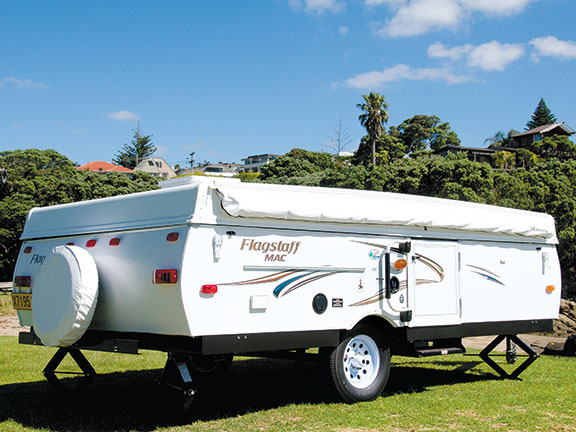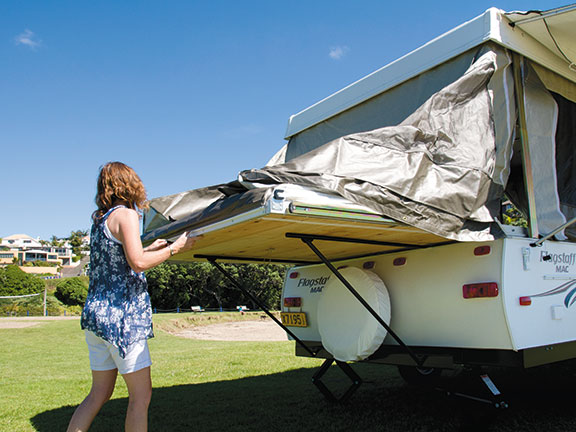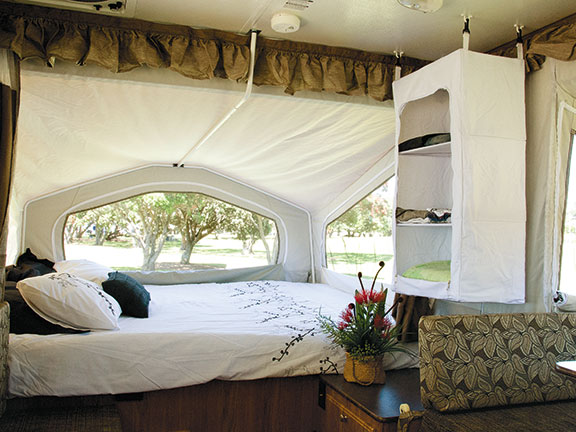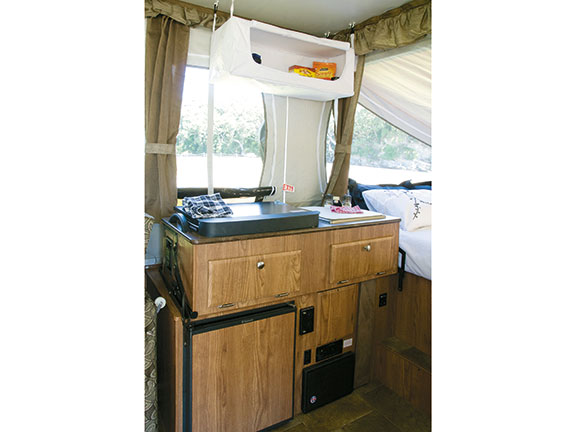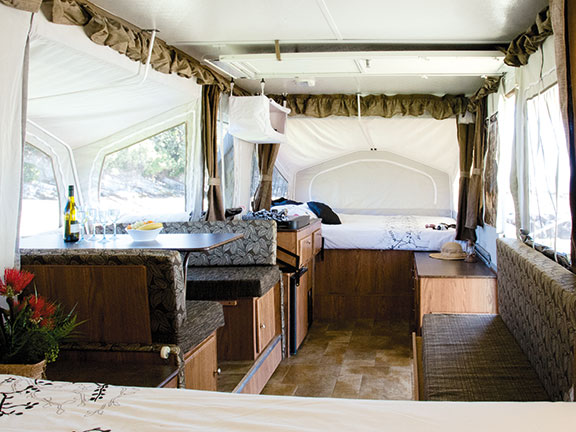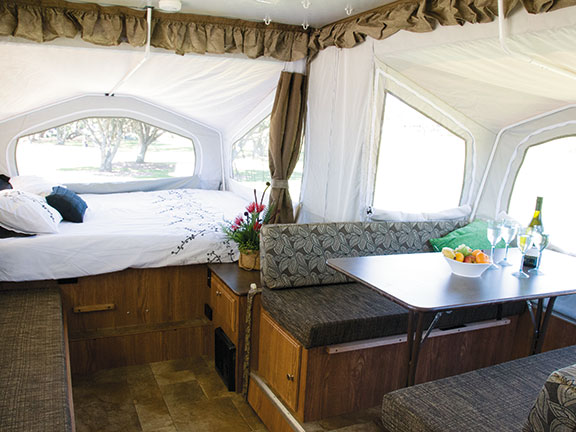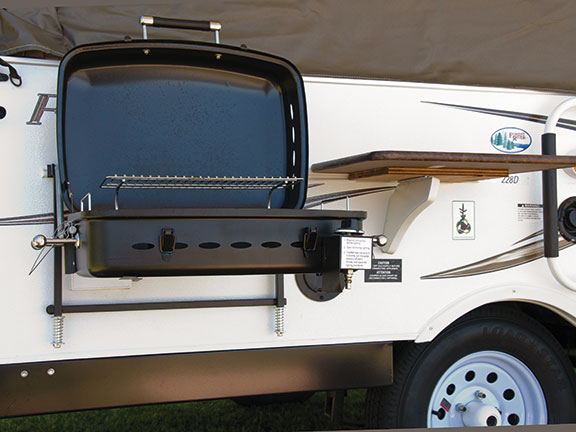Once the four clips securing the hard top were released, Lisa unfurled the awning. "It's too high off the ground to do it easily once the top is raised,' she explained. After checking the battery was good to go, Lisa flicked the switch on the power winch and literally 'raised the roof'. Once she had fitted the two roof safety supports, she deployed both slide-out beds and the dinette. Then we were able to move inside.
Lisa raised the galley into position before zipping canopy corners and locking the bed rails. It was then a simple matter of lifting the bunk and dinette canopy arms into position and adjusting them to tension the canopy. Once the dinette cushions were positioned and the freestanding table deployed, Lisa turned her attention to fitting the door. This appeared to me to be a serious bit of assembly work but it turned out to be as simple as repositioning the cushions. Following a set sequence of moves, Lisa soon had the door positioned, locked into place, and functioning. And that was 'job done'.
The transformation was amazing. I was now standing in space 7.3 metres long and nearly three metres wide at the dinette. There were beds everywhere. There was a king-size bed at one end and a queen-size at the other. The dinette for six is also a double bed and the settee converts into a single bed. The galley is equipped with a sink with its own filtered, pressurised water supply, a three-burner hob, and a small, 55-litre, three-way fridge sits below. Further inspection revealed an LPG fan heater to ward off winter chills, a 23-litre capacity hot water system should you need a hot (outside) shower and a 75-litre freshwater tank to supply it.
Before the top of the Flagstaff Mac was raised, I looked inside and it appeared to me to be chock full of cushions and equipment. Once the top was raised and everything put into place the interior looked very light and spacious. There are windows on all side walls. Each has a permanent insect screen, and a tinted vinyl window with a privacy curtain, that can be rolled up separately as needed. If the end beds are made up at home, the beds are available for use as soon as the top goes up. Should you need the settee and dinette as beds, their bedding can be stored in the lockers below the seats. There are drawers in cabinets at both ends of the Flagstaff Mac for further personal items and clothing. After nightfall there are three ceiling lights for illumination, but if you fancy a spot of bedtime reading, be sure to get first dibs on the bunk light. When you are connected to mains power, three double power points are available to keep all your various device batteries charged.
Lisa added a few personal touches and soon the Flagstaff Mac was looking like home. There were two very practical items that caught my eye. Over the galley she had installed a hanging pantry so the cook's essentials could be close at hand. A hanging wardrobe by the bed was perfect for those clothes, toiletries, and other personal items which missed out on locker space. Looking through to the end bedroom reminded me of pictures of luxury African safari tents I'd seen in glossy magazines. Never mind, I'll swap elephants and lions for tui and native wood pigeon.
Safety has not been overlooked. Beside the door the fire extinguisher is mounted at floor level and is easily accessible from inside or out. Inside are mounted carbon monoxide, smoke, and LPG detectors.
The frame holding the BBQ slots into a simple fitting that is attached to the side of the trailer. Place the BBQ in the frame and you are ready to cook. Lots of interest was show in this arrangement at the recent Auckland Covi Show. If you are cooking after sunset there is an awning light to guide you.
The roof is covered with a one-piece, vacuum-bonded fibreglass moulding and the sides with vacuum-bonded fibreglass sheet. The spare wheel and LPG bottle both have neat vinyl covers while the battery is housed in a watertight box. As the trailer sits quite high on the chassis, and although there is a very robust handrail beside the entry door, Lisa has opted to fit the outside step as standard. A sensible move where the very young and not so very old are concerned.
The Flagstaff Mac canopy is made from Vinolon, a synthetic woven fabric favoured by many US camper trailer producers over the years. It features five zip-out panels. If a panel should get damaged it can be easily replaced — a more convenient and less expensive remedy than having a canvas maker unstitch, remove, and then sew in a replacement panel. The canopy appears to be well designed and well made with double stitching on most seams. There are long skirts to channel rainwater below the 'canopy to body' joins at the side of the camper and flaps secured with Velcro tabs covering the zips.
When time comes to go home, in USA speak you 'tear down' the Flagstaff Mac. This is just the reverse of putting it up. Take care to fold and position the canopy where it joins the trailer so it doesn't leak water onto your bedding and to ensure the top fastens securely without trapping unwanted folds of canopy. To do the job properly Lisa reckons it takes longer — twenty minutes to tear down compared with 15 minutes putting it up.
Weighing just under a tonne as reviewed, the Flagstaff Mac was easy to tow and should be well within the capabilities of larger 2.0-litre family saloons, like the Ford Mondeo. It stands high enough to be easily seen through the rear window when reversing. Be aware, the trailer is fitted with electric brakes.
For more information contact Lisa Leveridge on (09) 479 2066 or 021 1151 541.
For the latest reviews, subscribe to our Motorhomes, Caravans & Destinations magazine here.

Review: JAC T9
For those passionate about adventuring with their caravan, one of the most important keys to success is a competent tow vehicle. We take a look at a newcomer to the market – the JAC T9.


